| |
Crash! Thud! A sea-green bomb tumbles through the palm fronds. Thunk! Another of Nature’s misshapen bowling balls falls from the overhead canopy. Scooping up one of these prizes, I head to the machete-wielding sulu-clad fellow who, with a whack or two of his insanely sharp knife, gains me access to the slightly sweet and undeniably refreshing juice inside my coconut.
I would partake of a number of coconut-sipping opportunities in Fiji, my favorite being those infused with some of the local rum, but it was a bit early in the day to start that indulgence. |
|
| |
|
|
| |
Never-ending smiles and music could be man’s greatest complement to Fiji’s natural profusion of tropical splendor |
|
| |
|
|
| |
The overnight flight on Air Pacific deposited me weary but excited in Nadi (NAN-di) on Fiji’s largest island, Viti Levu (VEE-tee LAY-vu). Clearing customs and zeroing in on baggage claim, I was delighted to find a jovial group of men in characteristic Fijian attire (“Aloha” shirt, sulu and sandals), singing a hearty welcome to travel-weary arrivals. I would discover this wasn’t a tourist show - everywhere I ventured I found music and laughter to be second nature with Fijians.
But I’m off to my coconut encounter on the shore where the first travelers arrived: Likuri Island. Popularly called Robin Crusoe Island, Likuri lies just off the southeastern coast of Viti Levu. |
|
| |
|
|
| |
Likuri is easily accessible by boat down the Tuba River, past undulating hillsides and herons stalking a meal in the mangroves |
|
Covering a low-lying 28 acres, Likuri is ringed with a white sand beach |
|
| |
|
|
|
|
The first arrivals definitely weren’t greeted with the ceremony our appearance brought to water’s edge
|
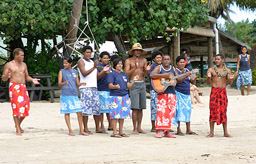 |
|
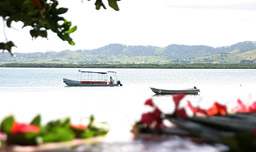 |
The “mainland” of Viti Levu is a 10-minute boat jaunt across the lagoon from Likuri |
| |
|
|
|
|
| |
Likuri’s first inhabitants are believed to have been the Lapita people, Polynesians who arrived 3,000-3,500 years ago as evidenced by a recently discovered pottery site on the island that dates to 1,500 BCE. Later making their way to the mainland of Viti Levu, Polynesians set aside Likuri for ceremonial use by the local paramount chief.
Only recently has the Island been opened to visitors, by partnering in an “eco-cultural budget resort.” Visitors now enjoy a revitalizing ride down the Tuba River, a quick crossing of a tranquil lagoon, and stepping ashore to the sound of music and song . A kava ceremony officially accepts tourist groups onto Robinson Crusoe Island, and finishes off the welcoming ceremony with a rain of coconuts, cut from the palm trees overhead. |
|
| |
|
|
| |
|
A quick dash up the coconut palm yields a hailing harvest of fresh fruit |
|
| |
|
|
| |
Likuri’s slow-paced atmosphere invites a stroll along great beachcombing sand, hermit crabs skittering out of your way. Laze in a hammock slung between perfect examples of South Pacific palms trees, trunks rising sway-backed from the sand, fronds leisurely dancing in the ocean breeze. Two boats can transport you to nearby coral reefs for diving and snorkeling, or you can paddle there yourself in a sea kayak. Accommodations include dorm, bure (thatched-roof native-style bungalow) and lodge; meals are served buffet-style with a daily change of menu. Robinson Crusoe Island welcomes day visitors as well as overnight/multi-night guests.
About 500 years after the Polynesians arrived, a group of Melanesians found their way to the Fijian islands, resulting in what is today considered the most pure of Polynesian/Melanesian cultures. In the meantime, the Lapita people and their unique style of pottery moved onto the mainland of Viti Levu. Similar in design to ancient African and Egyptian ceramics, archaeologists have named this form of pottery “Lapita style”. |
|
| |
|
|
| |
|
|
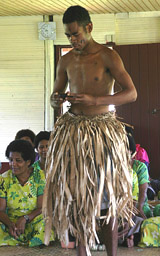 |
|
| |
Singing accompanies the brewing of the kava, pausing only for its serving to honored guests |
|
| |
|
|
| |
Today a handful of villages in the Sigatoka (SING-ga-TO-ka) Valley still practice this traditional method of pottery making, including Nakabuta, about 8 kilometers north of Sigatoka Town. Visitors to this village are welcomed with the customary kava ceremony, a demonstration of their craft, and singing and dancing, or meke. |
|
| |
|
|
| |
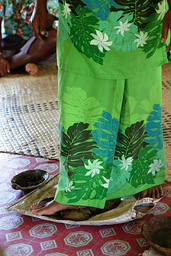 |
|
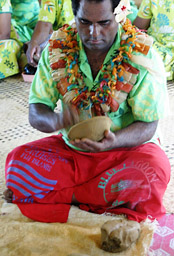 |
|
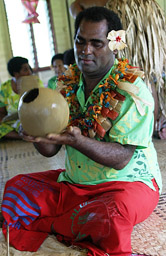 |
|
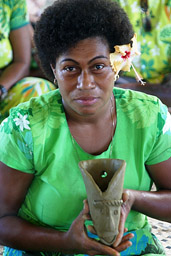 |
|
| |
The process begins by mixing sand into the clay until the right consistency is obtained |
|
One potter starts with a ball of clay, another flattens it and forms two bowls which will be joined to form a vase |
|
While one potter prepares to attach the vase rim... |
|
...another reveals her hanging vase with a whimsical face |
|
| |
|
|
|
|
|
|
|
|
| |
Most raw clay needs a material called temper to make it pliable and durable enough for ceramic items. Using their fine Fijian sand as temper, Nakabuta potters blend it with their feet until they get the texture they want. Using a stone and paddle to shape the clay, they then transform it into a variety of functional and decorative objects. |
|
| |
|
|
| |
Hot from the firing flames, a coating of tree resin provides a shiny, waterproof finish to Nakabuta pottery |
|
| |
|
|
| |
After drying completely in the sun, the ceramics are fired in an open blaze of wood and coconut husks. Deviations in oxygen level during firing provide a pleasing variation in colors on the finished pieces. Grabbed glowing hot from the fire, a coating of resin from the dakua tree is applied to make the item waterproof and leave a glossy appearance. |
|
| |
|
|
| |
After more meke, including being drawn to our feet to join in the taralala, the Fijian side-by-side, two-step shuffle, we had the opportunity to purchase Nakabuta pottery. I managed to keep myself under control as I perused vases and bowls, necklaces and bracelets (my favorite being those strung from small clay beads interspersed with tiny sea shells), masks and animal figures. I managed to keep my acquisitions to a reasonable volume and poundage, making certain to include one of those exquisite clay-and-shell necklaces.
Today’s Fijians are gentle and devout souls, filled with humor and generosity and a joy to be around. It is hard to reconcile them with the island’s history of cannibalism. Just a bit further inland from Nakabuta and their peaceful way of life was the last holdout of their ferocious forefathers. |
|
| |
|
|
| |
The Sigatoka Valley is known as Fiji’s “Salad Bowl” and holdout of the last cannibal tribes in the islands |
|
| |
|
|
| |
It was supposed to be less than an hour’s drive from Sigatoka Town through Fiji’s “Salad Bowl”, the Sigatoka Valley, to the River of the same name, with our final goal being Naihehe Cave. It’s a bucolic landscape of rolling hills, waterways of various size and depth, and dense tropical forest interspersed with a multihued mélange of land under produce cultivation, thus the Valley’s nickname. However, we encountered torrential rains flitting across some of the hills, feeding those waterways and the trip took an unexpected turn. |
|
| |
|
|
| |
The Sigatoka Valley is Fiji’s “Salad Bowl” thanks to bountiful fruit and vegetable crops |
|
The road disappears beneath an overflowing riverbank |
| |
|
|
|
| |
Rolling through the Valley, drooling past miles of papaya and banana plantations, our Adventures in Paradise van suddenly slowed and one of the guides jumped out with a SPLASH onto the roadway, water swirling at mid-calf level. At least we all hoped it was a roadway because all that could be seen beside, beneath and ahead of us was an inundation of water.
Sensing the pavement with his bare feet, our guide tracked a safe route for our driver. We continued to move from rain shower to brilliant sun and back again. Fortunately the road now remained visible. We passed the ancient hill fortress of Tavuni, deeper into Fiji’s cannibal history. |
|
| |
|
|
| |
Parts of the Sigatoka River are so shallow it is easier to jump in the water and tow the bilibili along |
|
Fresh fish and mussels are a tasty addition to the abundant produce grown in Fiji’s “Salad Bowl” |
|
| |
|
|
| |
Our two-hour-plus excursion eventually deposited us at the Sigatoka River, its 75 winding miles making it the second longest in Fiji and prized for its freshwater mussels. Boarding bamboo rafts called bilibilis, we made our way downstream, reflecting on the significance of what we were about to see. By the mid-nineteenth century, the last of the fierce local Tongan warrior tribes had retreated into this area, pushed back by the British army assisting the missionaries in their efforts to subjugate and convert the indigenous population. |
|
| |
|
|
| |
|
|
| |
As word of determined armed forces on the march reached the Sigatoka Valley, more than a hundred people fled to their sacred Naihehe Cave and spent months in hiding. Blessed with relatively easy yet defendable access, huge chambers, plenty of fresh air, and drinking water from underground springs, they could have done a lot worse for a hideout. We disembarked our bilibilis a ways downstream on the opposite shore and set out on a short hike through a forest of exotic foliage and an amazing variety of ginger plants. |
|
| |
|
|
| |
The entrance to Naihehe Cave appears innocent enough, belying its infamous history |
|
Fantastic cave formations include flowstones, stalactites and stalagmites |
|
| |
|
|
| |
Our flower-draped pathway ended abruptly at a small entry into the hillside. Making jokes and small talk, we attempted to mask our excitement and uneasiness as, one by one, we stepped down into the small stream we would follow, ducked, and entered a realm of geological magic and historical mystery. Marvelous rock formations greeted us as we moved from room to room, passing beneath huge archways, following the stream ever further into the mountainside. |
|
| |
|
|
| |
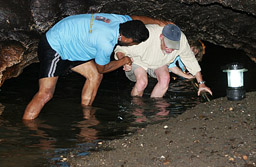 |
|
| |
Negotiating the Pregnancy Gap isn’t difficult, just a bit intimidating… think Limbo Bar in reverse |
|
| |
|
|
| |
We reached what appeared to be the end of the passable route, but to our amazement one of the guides grabbed a lantern, crouched low until his chest nearly brushed the stream, and disappeared. One by one we handed off our cameras to a guide who placed them inside a plastic storage box and floated them upstream through the passage. I stepped into the middle of the stream, crouched as low as my body would allow, reached out to run my fingers along a huge length of bamboo placed in the water to give the illusion of a handrail, and gingerly made my way through the Pregnancy Gap. |
|
| |
|
|
| |
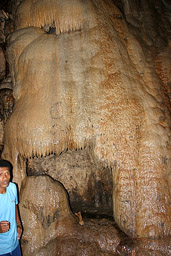 |
|
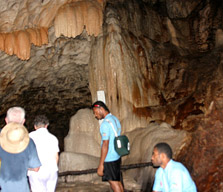 |
|
| |
Naihehe Cave’s cannibal oven was last used in 1867 |
|
The Ritual Platform was the stage for ceremonies conducted by pagan priests |
|
| |
|
|
|
|
| |
Legend says this “Gap” got its name because a woman who was with child but trying to hide her pregnancy would not be able to pass. While it barely slowed one of our group who was just two months shy of her due date, what the Gap does manage to accomplish is instill a sense of wonderment as you return your body to its upright position and suddenly see the great Cathedral Chamber stretching before you. Marvels include sleeping and Priests’ chambers, a Ritual Platform, and our ultimate goal: the Cannibal Oven.
Contrary to portrayal by cartoons and Hollywood, cannibal tribes of the South Pacific did not use huge kettles; they baked their enemies in the same underground ovens as their other food. This sort of baking unit being a bit difficult to construct in a sacred cave, they resorted to hollowing an oven out of a massive flowstone. It was this very oven that cooked the last “long pork” in Fiji: The Reverend Thomas Baker.
This unfortunate fellow visited the village of Nabutautau in 1867 with good intentions, but neglected to heed the customs and taboos of his intended converts. Even today you do not touch a Fijian on the head. Never. Very disrespectful. Details are a bit sketchy, but the Reverend attempted to do something that involved touching the noggin of – of all people – the chief. The immediate result of this insult was termination of Reverend Baker and his conversion attempts. |
|
| |
|
|
| |
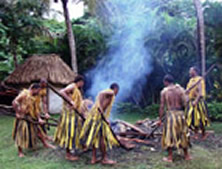 |
|
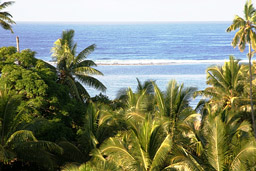 |
|
| |
Beqa Firewalkers perform at the Outrigger on the Lagoon |
|
Room views at the Outrigger include palm-framed breakers along the offshore reef |
|
| |
|
|
|
|
| |
While Fiji’s cannibal tribes were stoking fires in their ovens, other groups were fanning the glowing embers from their fires, preparing to demonstrate an ability which legend says was bestowed in appreciation over 500 years ago. Fire walking in Fiji originated on the islands of Beqa and Yanuca, located about a dozen miles south of Viti Levu. Today the best place to witness an authentic fire walking performance is along the Coral Coast of Viti Levu.
A number of resorts dot the Coral Coast, a 100 km stretch of coastline along the southwest portion of the island. White sand beaches and a huge fringing reef make this Fiji’s largest and most popular resort area, but you’d never know it from the highway. Five-star properties such as the Outrigger on the Lagoon, Shangri-La, Hideaway Resort, Warwick and Naviti are set out of sight between the road and the ocean, hidden by a jungle of tropical trees and flowers. Between resorts are miles of ocean vistas, a few towns and villages, and countless roadside stands selling mounds of freshly picked papaya at obscenely cheap prices. |
|
| |
|
|
| |
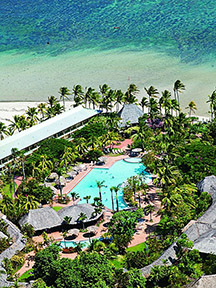 |
|
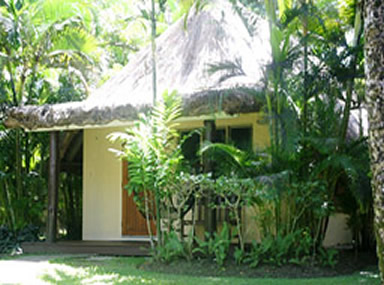 |
|
| |
Aerial view of the Outriggers’ central lagoon swimming pool (Photo courtesy of the Outrigger on the Lagoon-Fiji) |
|
Accommodations include Plantation bures scattered along paths that wind through 40 acres of lushly landscaped grounds |
|
| |
|
|
|
|
| |
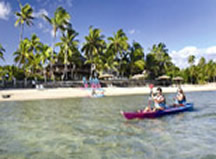 |
|
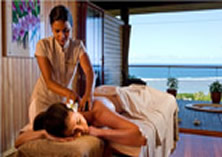 |
|
| |
All types of water sports gear is available at the Activities Center, or head to the driving range and chipping/putting green, tennis courts, or 24-hour fitness center (Photo courtesy of the Outrigger on the Lagoon-Fiji) |
|
Perched on Lomalagi Hill, the open air treatment rooms at Bebe Spa boast a panoramic view of the South Pacific (Photo courtesy of the Outrigger on the Lagoon-Fiji) |
|
| |
|
|
|
|
| |
The Outrigger on the Lagoon-Fiji is conveniently located ten minutes from Sigatoka Town, the lively little (pop. less than 10,000) business center of the Coral Coast. Straddling its namesake River, sugarcane and vegetables cover the hillsides outside of town. Taxis are plentiful and inexpensive, and local buses ply the highway on a regular basis.
But you don’t need to head off-property to enjoy five-star food and libations. Breakfast, lunch and dinner is served, buffet and ala carte, at the Vale Ni Kana, a massive palapa-style restaurant with an intimate feel. The Vakavanua Lounge is popular for a pre-dinner drink, while the Sundowner Bar also offers pizza and salads along with a stunning beachfront sunset view. Up on the mountain ridge adjacent to the Bebe Spa, the Kalokalo Bar is reputed to have the best view of any bar in Fiji. Not having visited all the bars in Fiji I can only say that I cannot imagine a better panorama of a tropical paradise.
Among all the activities available at the Outrigger, I was enthralled with the beachcombing. The shorelines I encountered in Fiji yielded shells and bits of coral in such abundance, many evenings I was forced to cull my expanding horde to avoid over-weight penalties at the airport. To my great enjoyment, the Outrigger boasted piles of sea treasures along its seawall, the result of raking the sand clean of ocean debris.
Poking among these mounds for unbroken shells and interesting coral tidbits, I was mesmerized watching hermit crabs scamper about in varied choices of dwelling apparel.
Suddenly the long handle of a sand rake overturned a nearby chunk of coral and pointed to a perfect, delicate shell of a type I’d not previously seen. I looked up to see a young man sitting on the seawall, clad in the Resort Security garb of crisp white shirt, pressed sulu, knee-high socks, and sandals - a vision from Fiji’s colonial days under the British. A huge grin showed his pleasure at having uncovered a keepsake for me, and he continued to point out hidden jewels from the sea as we chatted about our lives. |
|
| |
|
|
| |
|
|
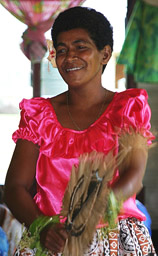 |
|
| |
Fijians are predisposed to beaming smiles and enthusiastic Bula’s. never too busy to stop their work and talk with an inquisitive visitor |
|
| |
|
|
| |
One of my most lasting impressions of Fiji, and one I will always cherish, is the people and their ubiquitous “bula”. A greeting that bestows life and love on the recipient, Fijians believe that the bigger and louder the bula, the more life they send your way. And it’s not just the hearty manner in which it is voiced, but its flamboyant accompaniment of arms waving overhead and ear-to-ear smiles. It is impossible not to grin in return. It is given to everyone, any time of the day.
The Bula became so ingrained from my Fiji experience, the first few days upon my return stateside I had to catch myself to keep from Bula’ing everyone around me. Arriving in Fiji, I was self-conscious to greet people in this manner, but within 24 hours it was evident Bula is part of the culture, given often and freely to everyone, but entirely heartfelt. I began to exchange Bula’s with shopkeepers and school children, farmers and fellow travelers.
Ready to experience your own Bula epiphany? Air Pacific has non-stop, overnight flights out of LAX four times each week for North American mainland flyers as well as flights out of Honolulu. This is an airline that still feeds you, often and well, while insomniacs enjoy a seat-back-screen entertainment system.
To assist in deciphering that where-to-go and what-to-do in Fiji, the Moon Fiji handbook by David Stanley comes to your rescue. With a Ninth Edition issued in February 2011, its 7-1/2” x 5-3/4” travel-friendly size contains 419 pages of well-organized and up-to-date facts, maps and practical tips. |
|
| |
|
|
| |
411:
For a limited time, Fijifriendly.com is offering a fantastic deal: purchase one round trip, economy class fare and receive a second fare for 50% off! Fly from Los Angeles or Honolulu to Fiji, Sydney, Brisbane,Melbourne, Auckland, Christchurch, Apia, Port Villa, Honiara or Tonga. To qualify, one passenger must pay full fare and travel with a companion that pays 50% off the second fare. Flights must be booked by December 31, 2011 and travel must be completed by March 31, 2012. This fare includes 1 free stopover in Fiji. Plus, enter to win a trip to Fiji until September 30, 2011 at Fijifriendly.com. Now that’s friendly!
Tourism Fiji www.FijiMe.com; info@TourismFijius.com
Robinson Crusoe Island www.RobinsonCrusoeIslandFiji.com; robinsoncrusoe@connect.com.fiji
Adventures in Paradise www.AdventuresinParadisFiji.com; wfall@connect.com.fj
Outrigger on the Lagoon - Fiji www.OutriggerFiji.com
Bebe Spa www.BebeSpaFiji.com
Air Pacific www.AirPacific.com; reservations@AirPacific.com |
|
| |
|
|
|
|
|


